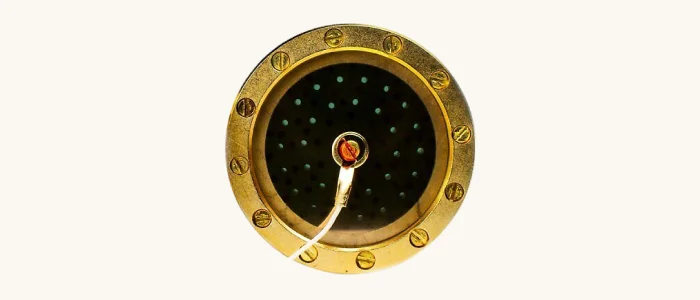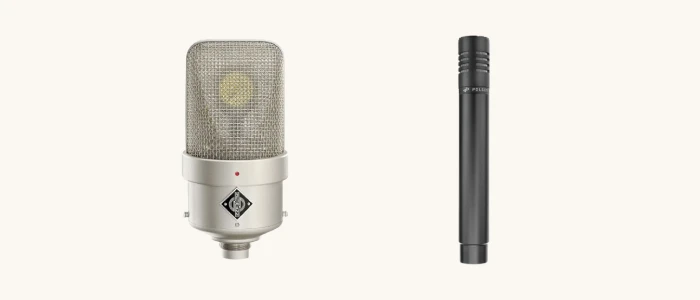If you want to know how condenser microphones and use them properly to create better-sounding mixes, then this guide is for you.
A condenser microphone is a type of microphone with a sensitive diaphragm and has a wide range of frequency responses. It picks up input signals faster and is great for recording in quiet environments.
Because of their sensitivity, wide frequency response, and fidelity, condenser mics are great for recording vocals and acoustic instruments such as acoustic guitars, ukuleles, etc.
How Do Condenser Mics Work?
In order to not get too technical, I will try to explain how a condenser mic works in simple words and why it’s a great recording microphone.
The main component of a condenser microphone is a capacitor that gives the character and ability to capture a wide range of sound and produce crisp and rich tones.
The capacitor consists of two metal plates – diaphragm and back plate – and an additional component capsule that is placed between them.

When a sound goes into the diaphragm, the pressure creates vibration against the back plate which causes voltage fluctuation. After that, an electrical signal is created and an external power supply helps to amplify the sound.
It may sound too technical for you but all this helps the condenser mic to produce a unique, rich, and wide range of sound that is great for recording.
Large Diaphragm vs Small Diaphragm
There are two types of condenser mics – large and small diaphragms – and each has its own sound and characteristics.
As the name suggests one type has a large diaphragm and another one has a small diaphragm but that’s not the only difference between them.

Large-diaphragm condenser microphones tend to capture a wide range of sound and have more depth. That’s why this type is mostly used for acoustic instruments and vocals.
On the other hand, a small diaphragm microphone captures transients and high frequencies better. For its characteristics, a condenser mic with a small diaphragm is used with guitar amps for recording. Many times paired with a dynamic mic to create versatile sound.
In general, each type of mic can work in any situation but large diaphragm mics are mostly used for recording vocals. Also, both types work and sound great when paired with a dynamic microphone.
How To Use A Condenser Microphone
So, you have an understanding of what is a condenser mic and how it works. Now, let me explain how to use it and which one is best to record instruments and vocals.
In general, you can use both types of condenser mics for recording any sound you want whether it’s an instrument, vocal, or any other sound. But each mic works better in specific situations.
For example, because of the characteristics, a large diaphragm condenser mic is great for recording lead vocals, backing or group vocals, acoustic guitars, or other instruments.
I have used it to record ukuleles and mandolins and the result was excellent. Not only it captured the sound of the instrument but the sound of the room too and added natural reverb to it.
Also, it can be used as a room mic and is great for drums or as a second mic for the guitar amp. If you record guitar amps with a dynamic microphone, you can use a condenser mic to capture room sound.
Just place a large diaphragm condenser microphone far from the amp to capture the room sound and add natural reverb. Then you can blend two tracks together and will have a richer and more in-depth sound.
I like to use small diaphragm condenser microphones for recording guitar and bass amps, pianos, and snare drums.
You get a more focused sound with a small diaphragm condenser and it captures high frequencies and transients better in my opinion.
However, I have recorded acoustic guitars with small diaphragm mics and it works perfectly.
I think both mics can be used to record anything you want and with proper mic placement, you will get great results.
But in general, a large diaphragm is a good vocal mic and for acoustic instruments and a small diaphragm is great for guitar amps and drums.
Recording With Condenser Mics
One thing you need to consider before recording with a condenser mic is the phantom power which is something like an external power that delivers DC to mics.
Every condenser microphone requires a phantom power to work properly. Without it, you won’t be able to record the sound through it.
So, if you are using a USB audio interface as your recording device, make sure it has a phantom power option. Of course, it also must have an input for a mic.
It may have a switch for it with a label of +48V or something like that. If your audio interface doesn’t have it, then you can use only dynamic microphones.
Conclusion
A condenser microphone is a type of microphone that is used in every recording session. You can use a large diaphragm or small diaphragm condenser mic for different instruments. I hope this guide will help you to better understand how they work and you will use its benefits to record great mixes.
